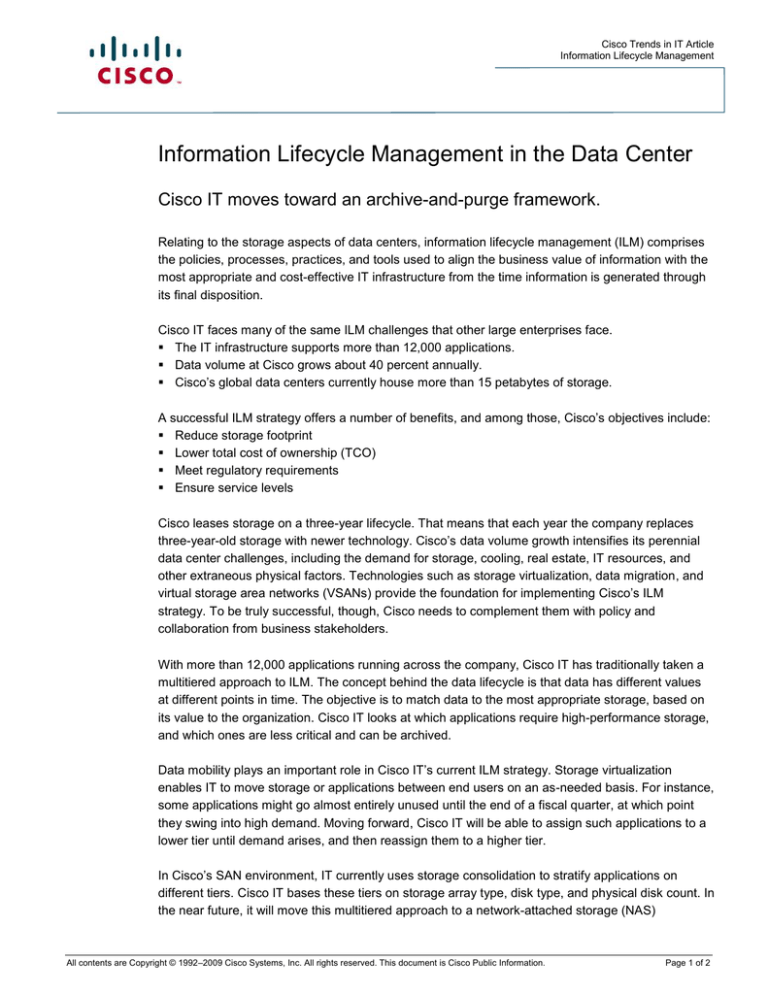
Cisco Trends in IT Article
Information Lifecycle Management
Information Lifecycle Management in the Data Center
Cisco IT moves toward an archive-and-purge framework.
Relating to the storage aspects of data centers, information lifecycle management (ILM) comprises
the policies, processes, practices, and tools used to align the business value of information with the
most appropriate and cost-effective IT infrastructure from the time information is generated through
its final disposition.
Cisco IT faces many of the same ILM challenges that other large enterprises face.
The IT infrastructure supports more than 12,000 applications.
Data volume at Cisco grows about 40 percent annually.
Cisco’s global data centers currently house more than 15 petabytes of storage.
A successful ILM strategy offers a number of benefits, and among those, Cisco’s objectives include:
Reduce storage footprint
Lower total cost of ownership (TCO)
Meet regulatory requirements
Ensure service levels
Cisco leases storage on a three-year lifecycle. That means that each year the company replaces
three-year-old storage with newer technology. Cisco’s data volume growth intensifies its perennial
data center challenges, including the demand for storage, cooling, real estate, IT resources, and
other extraneous physical factors. Technologies such as storage virtualization, data migration, and
virtual storage area networks (VSANs) provide the foundation for implementing Cisco’s ILM
strategy. To be truly successful, though, Cisco needs to complement them with policy and
collaboration from business stakeholders.
With more than 12,000 applications running across the company, Cisco IT has traditionally taken a
multitiered approach to ILM. The concept behind the data lifecycle is that data has different values
at different points in time. The objective is to match data to the most appropriate storage, based on
its value to the organization. Cisco IT looks at which applications require high-performance storage,
and which ones are less critical and can be archived.
Data mobility plays an important role in Cisco IT’s current ILM strategy. Storage virtualization
enables IT to move storage or applications between end users on an as-needed basis. For instance,
some applications might go almost entirely unused until the end of a fiscal quarter, at which point
they swing into high demand. Moving forward, Cisco IT will be able to assign such applications to a
lower tier until demand arises, and then reassign them to a higher tier.
In Cisco’s SAN environment, IT currently uses storage consolidation to stratify applications on
different tiers. Cisco IT bases these tiers on storage array type, disk type, and physical disk count. In
the near future, it will move this multitiered approach to a network-attached storage (NAS)
All contents are Copyright © 1992–2009 Cisco Systems, Inc. All rights reserved. This document is Cisco Public Information.
Page 1 of 2
Cisco Trends in IT Article
Information Lifecycle Management
environment. Cisco IT can use this array and disk tiering, along with application data classification and
aging, for a large portion of filer data to create a more cost-effective model.
Cisco IT is now moving toward an archive-and-purge framework for ILM. It is partnering with the
business stakeholders to create the data classification and management policies that are the basis of
this framework. The goal is to collaboratively define “working” and “archive” data sets, and to
determine the useful lifecycle of data and define appropriate, realistic business policy.
Depending on what Cisco IT discovers in terms of business policy, working collaboratively with other
groups in the company will give the Cisco IT storage architects an opportunity either to maintain and
manage growth, or even to shrink its storage footprint. Cisco IT’s archive-and-purge strategy will be
the enabler it needs to achieve ILM objectives.
For more on strategies and operations in the data center, see the interactive Cisco IT Data Center
Experience at www.cisco.com/go/virtualdatacenter.
All contents are Copyright © 1992–2009 Cisco Systems, Inc. All rights reserved. This document is Cisco Public Information.
Page 2 of 2


